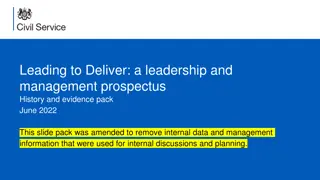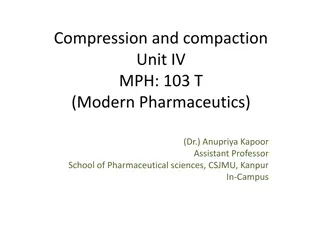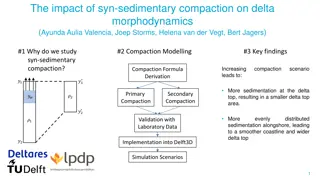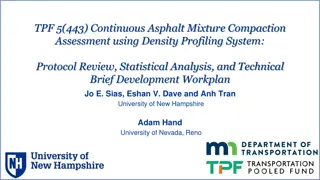Effective Compaction Techniques for Civil Engineering Projects
Understanding the variables involved in soil compaction operations is crucial for developing a successful compaction plan. Factors such as soil moisture content, lift thickness, number of passes, ground contact pressure, compactor weight, and speed play key roles in achieving optimal compaction results. It is important to consider the compactive effort delivered by the compaction equipment, as it may vary from laboratory tests. Maintaining thin lift thickness for effective compaction and understanding the impact of repeated passes on density are also essential aspects of compaction operations.
Download Presentation

Please find below an Image/Link to download the presentation.
The content on the website is provided AS IS for your information and personal use only. It may not be sold, licensed, or shared on other websites without obtaining consent from the author.If you encounter any issues during the download, it is possible that the publisher has removed the file from their server.
You are allowed to download the files provided on this website for personal or commercial use, subject to the condition that they are used lawfully. All files are the property of their respective owners.
The content on the website is provided AS IS for your information and personal use only. It may not be sold, licensed, or shared on other websites without obtaining consent from the author.
E N D
Presentation Transcript
Chapter 5 Compacting and Finishing Part 2 CE 417 King Saud University 1
Compaction Operations After selecting appropriate compaction equipment, a compaction plan must be developed. The major variables to be considered include: soil moisture content, lift thickness, number of passes used, ground contact pressure, compactor weight, and compactor speed. For vibratory compactors, it is also necessary to consider the frequency and amplitude of vibration to be employed. CE 417 King Saud University 2
Compaction Operations the compactive effort delivered by a piece of compaction equipment will seldom be exactly the same as that of either the standard or modified compaction test. Thus, the field optimum moisture content for a particular soil/compactor combination will seldom be the same as the laboratory optimum. CE 417 King Saud University 3
Compaction Operations This is illustrated by Figure 5-11, where only one of the four compactors has a field optimum moisture content close to the laboratory optimum. CE 417 King Saud University 4
FIGURE 5-11: Variation of optimum moisture content with roller type. (From reference 6) CE 417 King Saud University 5
Compaction Operations Lifts thicknesses : It should be kept thin for most effective compaction. For all rollers, except vibratory rollers and heavy pneumatic rollers, a maximum of 5 to 8 in. (15 to 20 cm). The maximum lift thickness depends on the static weight of the compactor. CE 417 King Saud University 6
Compaction Operations The compaction achieved by repeated passes: The compaction achieved by repeated passes of a compactor depends on the soil/compactor combination utilized. For some combinations (such as a tamping foot roller compacting a clayey gravel), significant increases in density may continue to occur beyond 50 passes. As shown in Figure 5-12, the increase in density is relatively small after about 10 passes for most soil/compactor combinations. CE 417 King Saud University 7
FIGURE 5-12: Typical effect of number of passes. CE 417 King Saud University 8
Compaction Operations Effect of Ground contact pressure on Compaction: for a tamping foot roller, Ground contact pressure may vary from: 30 lb/sq in. (207 kPa) for a pneumatic roller to 300 lb/sq in. (2070 kPa) or more. Within these ranges it has been found that: total roller weight has a much more pronounced effect on the compaction achieved than does contact pressure. The use of excessive ground contact pressure will result in shearing and displacement of the soil being compacted. CE 417 King Saud University 9
Compaction Operations Effect of Travel time on Compaction: Except for vibratory compactors, tests have shown little relationship between compactor travel speed and the compaction achieved. For vibratory equipment, travel speed (at a fixed operating frequency) determines the number of vibrations that each point on the ground surface will receive. Therefore, when using vibratory equipment, tests should be performed to determine the compactor speed that results in the highest compactor productivity. For conventional equipment the highest possible speed should be utilized that does not result in excessive surface displacement. CE 417 King Saud University 10
Estimating Compactor Production Equation 5-1 may be used to calculate compactor production based on: compactor speed, lift thickness, and effective width of compaction. The accuracy of the result obtained will depend on the accuracy in estimating speed and lift thickness. Trial operations will usually be necessary to obtain accurate estimates of these factors. Typical compactor operating speeds are given in Table 5-3. CE 417 King Saud University 11
TABLE 5-3: Typical operating speed of compaction equipment CE 417 King Saud University 12
Estimating Compactor Production Production (CCY/h)= 16.3 W S L E / P (5-lA) Production (CCM/h) = 10 W S L E / P (5-lB) Where P = number of passes required W = width compacted per pass (ft or m) S = compactor speed (mi/h or km/h) L = compacted lift thickness (in. or em) E = job efficiency CE 417 King Saud University 13
Estimating Compactor Production The power required to tow rollers depends on the roller's total resistance (grade plus rolling resistance). The rolling resistance of tamping foot rollers has been found to be approximately 450 to 500 lb/ton (225 to 250 kg/t). The rolling resistance of pneumatic rollers and the maximum vehicle speed may be calculated by the methods of Chapter 4. CE 417 King Saud University 14
Job Management trial operations are usually required to determine: the exact values of soil moisture content, lift thickness, compactor weight, and vibrator frequency and amplitude that yield maximum productivity while achieving the specified soil density. The use of a nuclear density device to measure the soil density actually being obtained during compaction is strongly recommended. CE 417 King Saud University 15
Job Management Traffic planning and control is an important factor in compaction operations. Hauling equipment must be given the right-of- way without excessively interfering with compaction operations. CE 417 King Saud University 16
5-3 SOIL STABILIZATION Soil stabilization has been defined as: the process of giving natural soils enough abrasive resistance and shear strength to accommodate traffic or loads. Soil stabilization methods include: mechanical methods (Read from the Textbook), hydraulic methods (Read from the Textbook), reinforcement methods (Read from the Textbook), and physiochemical methods. Some techniques falling under each of these categories are shown in Table 5-4. CE 417 King Saud University 17
TABLE 5-4: Soil stabilization methods CE 417 King Saud University 18
5-4 GRADING AND FINISHING Grading is the process of bringing earthwork to the desired shape and elevation (or grade). Finish grading, or simply finishing, involves: smoothing slopes, shaping ditches, and bringing the earthwork to the elevation required by the plans and specification. Finishing usually follows closely behind excavation, compaction, and grading. Finishing, in turn, is usually followed closely by seeding or sodding to control soil erosion. CE 417 King Saud University 19
5-4 GRADING AND FINISHING The piece of equipment most widely used for grading and finishing is the motor grader (Figure 5-13). Grade trimmers and excavators are frequently used on large highway and airfield projects because their operating speed is greater than that of the motor grader. CE 417 King Saud University 20
FIGURE 5-13: Modern motor grader. (Courtesy of Fiatallis North America, Inc.) CE 417 King Saud University 21
5-4 GRADING AND FINISHING In highway construction, the process of cutting down high spots and filling in low spots of each roadway layer is called balancing. Trimming is the process of bringing each roadway layer to its final grade. CE 417 King Saud University 22
FIGURE 5-14: Typical roadway components. CE 417 King Saud University 23
5-4 GRADING AND FINISHING Motor Grader Grade Excavators and Trimmers Estimating Grader Production Job Management CE 417 King Saud University 24
Motor Grader The motor grader is one of the most versatile items of earthmoving equipment. It can be used for: light stripping, grading, finishing, trimming, bank sloping, ditching, backfiling, and scarifying. CE 417 King Saud University 25
Motor Grader It is also : capable of mixing and spreading soil and asphaltic mixtures. used on building construction projects as well as in heavy and highway construction. It is frequently used for the maintenance of highways and haul roads. CE 417 King Saud University 26
Motor Grader The blade of a motor grader: is referred to as a moldboard and is equipped with replaceable cutting edges and end pieces (end bits). The wide range of possible blade positions is illustrated in Figure 5-15. CE 417 King Saud University 27
FIGURE 5-15: Blade positions for the motor grader. (U.S. Department of the Army) CE 417 King Saud University 28
Motor Grader Motor graders are available with articulated frames that increase grader maneuverability. The three possible modes of operation for an articulated grader are illustrated in Figure 5-16. CE 417 King Saud University 29
FIGURE 5-16: Articulated grader positions. CE 417 King Saud University 30
Motor Grader The machine operation modes are: Conventional manner when in the straight mode (Figure 5-16A). Articulated mode (Figure 5-16B) to allow the machine to turn in a short radius. the crab mode (Figure 5-16C) permits the rear driving wheels to be offset so that they remain on firm ground while the machine cuts banks, side slopes, or ditches. CE 417 King Saud University 31
Motor Grader The front wheels of both conventional and articulated graders may be leaned from side to side. Wheels are leaned away from the cut to: offset the side thrust produced by soil pressure against the angled blade. assist in turning the grader. CE 417 King Saud University 32
Motor Grader Graders are available with automatic blade control systems that: permit precise grade control. utilize a sensing system that follows an existing surface, string line, or laser beam to automatically raise or lower the blade as required to achieve the desired grade. CE 417 King Saud University 33
Grade Excavators and Trimmers Grade excavators or trimmers: theyare machines that are capable of finishing roadway and airfield subgrades and bases faster and more accurately than can motor graders. Many of these machines also act as reclaimers. they are capable of scarifying and removing soil and old asphalt pavement. CE 417 King Saud University 34
FIGURE 5-17: Large grade trimmer/reclaimer/paver. (Courtesy of CMI Corp.) CE 417 King Saud University 35
Grade Excavators and Trimmers Grade trimmers: They lack the versatility of motor graders. They are very useful on large roadway and airfield projects. Because of their accuracy and high speed. Their large size often requires that they be partially disassembled and transported between job sites on heavy equipment trailers. CE 417 King Saud University 36
Estimating Grader Production Grader production is usually calculated: on a linear basis (miles or kilometers completed per hour) for roadway projects and on an area basis (square yards or square meters per hour) for general construction projects. The time required to complete a roadway project may be estimated as follows: CE 417 King Saud University 37
Estimating Grader Production Average speed will depend on: operator skill, machine characteristics, and job conditions. Typical grader speeds for various types of operations are given in Table 5-6. CE 417 King Saud University 38
TABLE 5-6: Typical grader operating speed CE 417 King Saud University 39
EXAMPLE 5-1 require reshaping and leveling. You estimate that six passes of a motor grader will be required. Based on operator skill, machine characteristics, and job conditions, you estimate two passes at 4 mi/h (6.4 km/h), two passes at 5 mi/h (8.0 km/h), and two passes at 6 mi/h (9.7 km/h). If job efficiency is 0.80, how many grader hours will be required for this job? Fifteen miles (24.1 km) of gravel road CE 417 King Saud University 40
EXAMPLE 5-1 Solution CE 417 King Saud University 41
Job Management to maximize grader production efficiency, it is required: Careful job planning, the use of skilled operators, and competent supervision. Use the minimum possible number of grader passes to accomplish the work. Eliminate as many turns as possible. CE 417 King Saud University 42


![❤[PDF]⚡ Civil War Talks: Further Reminiscences of George S. Bernard and His Fel](/thumb/20551/pdf-civil-war-talks-further-reminiscences-of-george-s-bernard-and-his-fel.jpg)




















